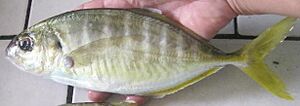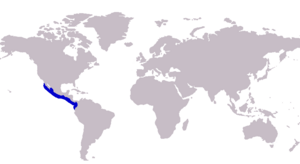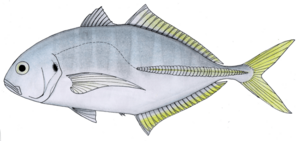Cocinero facts for kids
Quick facts for kids Cocinero |
|
|---|---|
 |
|
| Conservation status | |
| Scientific classification | |
 |
|
| Approximate range of the cocinero | |
| Synonyms | |
|
The cocinero (Caranx vinctus) is a small ocean fish. It is also known as the barred jack or striped jack. This fish belongs to the jack family, called Carangidae. Cocineros live in the warm eastern Pacific Ocean. You can find them along the west American coast. Their range goes from Baja California in the north to Peru in the south.
Cocineros are pelagic species. This means they live in the upper parts of the water. They can be found both near the coastal shore and far out in the ocean. Sometimes, they even swim into estuaries (where rivers meet the sea). You can spot them by their unique look. They have 8 or 9 dark stripes on their sides. Cocineros are smaller than many other Caranx fish. They can grow up to 37 centimeters long. This fish is a predator. It eats small fish, crustaceans, and other tiny sea creatures. Cocineros are important for fishing in some areas. People also use them in aquaculture (fish farming) experiments.
What is a Cocinero?
The cocinero is a type of fish in the Caranx group. This group is often called jacks or trevallies. The Caranx group is part of the larger jack and horse mackerel family. This family is known as Carangidae. All these fish belong to the order called Carangiformes.
Scientists first described the cocinero in 1882. Two American fish experts, David Starr Jordan and Charles Henry Gilbert, named it. They found a specimen (example fish) off Sinaloa, Mexico. They named it Caranx vinctus. The word vinctus comes from Latin. It means "bound" or "laced." This name likely refers to the fish's vertical stripes. The common name, cocinero, is Spanish for "cook" or "chef."
How to Spot a Cocinero
The cocinero is quite small compared to most other Caranx fish. It can grow up to 37 centimeters long. Its body shape is similar to other jacks. It is somewhat deep and flattened from side to side. The top of its body is a bit more curved than the bottom. Its snout (nose area) is slightly pointed.
The cocinero has two dorsal fins on its back. The first fin has eight stiff spines. The second fin has one spine and 22 to 24 soft rays. Its anal fin is on its underside. It has two separate spines at the front. Then it has one spine and 18 to 21 soft rays.
The cocinero's body is dusky-blue on top. This color fades to a silvery-white on its belly. Sometimes, it has golden-green reflections when it is fresh. The most noticeable feature is the 8 or 9 dark vertical bars on its sides. It also has a clear dark spot on its upper gill cover. Young cocineros are much paler. Their dark stripes are even more noticeable.
Where Cocineros Live
Cocineros live in the warm and subtropical waters of the eastern Pacific Ocean. They are found along the American coastline. Their range stretches from Baja California in the north to Peru in the south. They might also live in the Gulf of California.
Cocineros are pelagic fish. This means they swim in the open water. They usually stay in the top 40 meters of the ocean. You can find them both far from shore and close to the coast. They have also been seen in estuaries and mangrove areas. The number of cocineros caught by fishers can change. This often depends on weather events like El Nino and La Nina.
Cocinero Life and Fishing
Scientists do not know much about the cocinero's life. We know what they eat and how fast they grow for a short time. This fish is a predator. It eats small fish and crustaceans. It also eats different benthic invertebrates (small creatures living on the seafloor) in shallow waters.
The cocinero is somewhat important for fishing. This is especially true in western Central America and South America. Fishers catch them mainly using different kinds of nets. The exact number of cocineros caught is not usually recorded. Instead, they are grouped with other Caranx species. People sell cocineros fresh, salted, or dried.
Scientists have also tried raising cocineros in cages. This is a type of aquaculture. The fish did not grow very well in these studies. However, they had a low mortality rate. This means not many of them died. They also seemed healthy, without many parasites or diseases. The cocinero is also a gamefish. People enjoy catching them with a fishing line or a spear.



